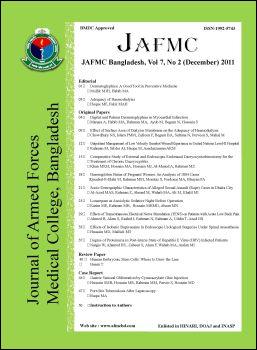Comparative Study Of External And Endoscopic Endonasal Dacryocystorhinostomy For The Treatment Of Chronic Dacryocystitis
DOI:
https://doi.org/10.3329/jafmc.v7i2.10389Keywords:
Dacryocystorhinostomy, endoscopic, externalAbstract
Introduction: Dacryocystorhinostomy (DCR) is the treatment of choice for Chronic Dacryocystitis. Although external DCR is still regarded as gold standard for acquired naso-lacrimal duct obstruction, endoscopic DCR is evolving as an equally effective alternative in the recent past.
Objective: The study was carried out to compare the surgical outcome of external DCR and endoscopic endonasal DCR for the treatment of Chronic Dacryocystitis.
Method: This observational study was carried out in the Department of Ophthalmology, Combined Military Hospital, Dhaka from November 2008 to May 2009. A total of 30 consecutive patients were selected for DCR surgery. Among those 15 patients underwent endoscopic endonasal DCR and 15 under went patients external DCR. Data regarding ocular examination, lacrimal drainage system, per-operative and postoperative complications and ultimate surgical outcome were collected and analyzed. Surgical success was defined by patient's resolution of symptoms with patency of lacrimal drainage system. Failure was defined as no symptomatic reduction in epiphora and/or inability to irrigate the lacrimal drainage system postoperatively.
Results: Mean age of the patients was 35.0±11.3 years. Fifty three percent of the study subject was male and 43% of the study subject was female. Accumulated result showed that both surgical approaches had almost similar success rate (endoscopic DCR 73.3% versus external DCR 80%; p=0.666). Complication rate was low and no appreciable difference in complication was marked in both types of surgery. Twenty percent in endoscopic DCR group and 13.3% in external DCR group had moderate bleeding. Two patients (13.3%) of endoscopic surgery required septoplasty. All the complications were managed by conservative treatment. Post operative complication particularly nonpatent lacrimal drainage system occurred to 26.7% of endoscopic group and 20% of those with external DCR surgery. Silicon tube was in situ up to 3 months in all the cases. Ultimate failure occurred in 26.7% for endoscopic DCR and 20% for external DCR.
Conclusions: Surgical outcome of both endoscopic and external DCR for Chronic Dacryocystitis was quite satisfactory. Overall complication rate was low. Endoscopic surgery might have an advantage of not having any external scar but it requires high equipment cost and long learning curve.
DOI: http://dx.doi.org/10.3329/jafmc.v7i2.10389
JAFMC 2011; 7(2): 15-17
Downloads
184
534

